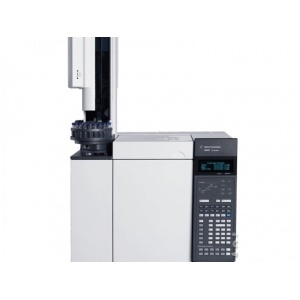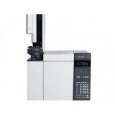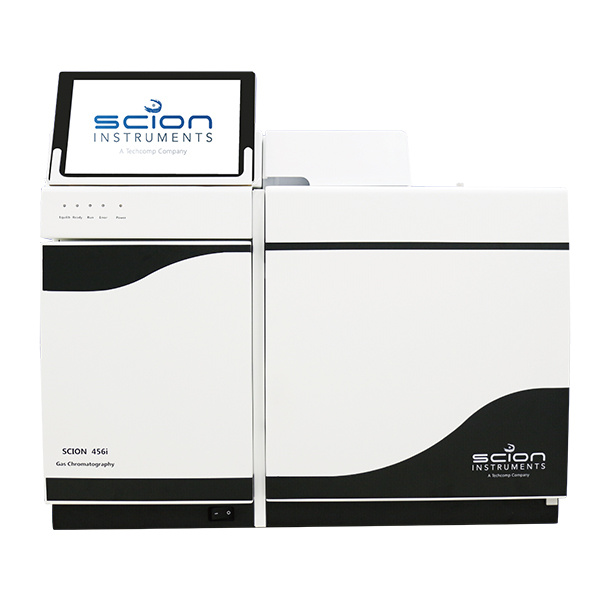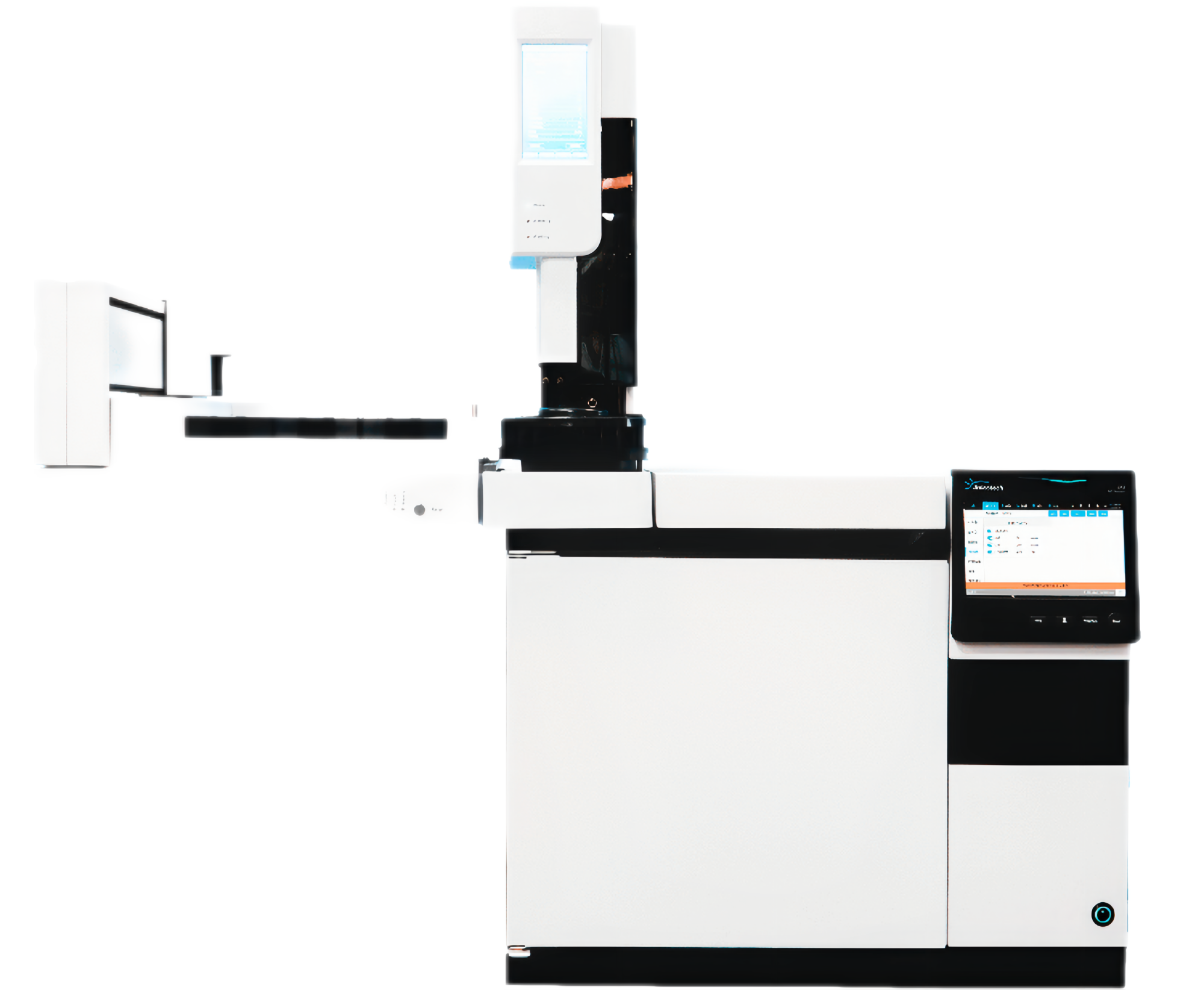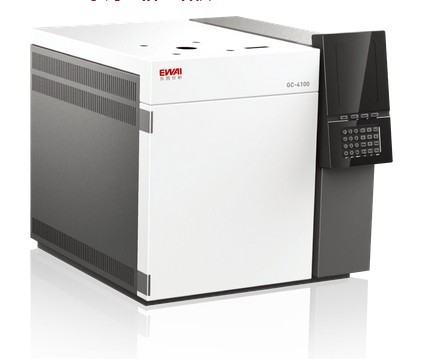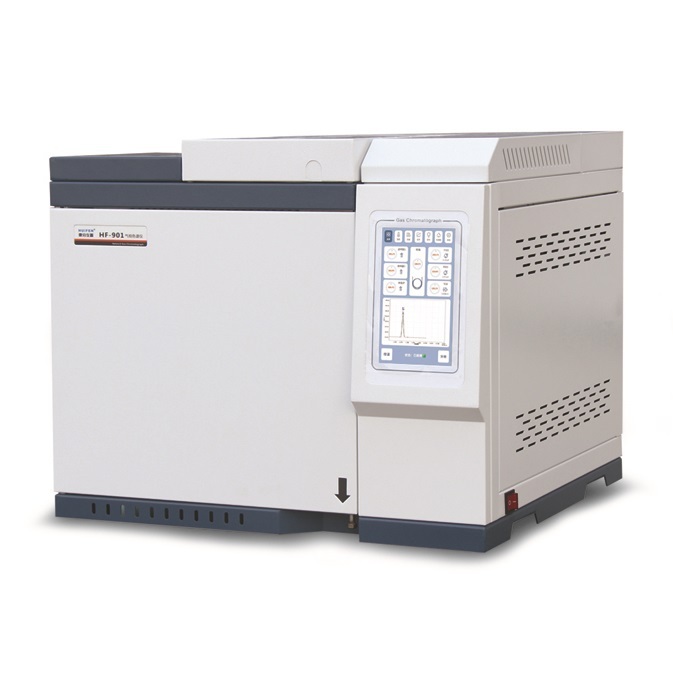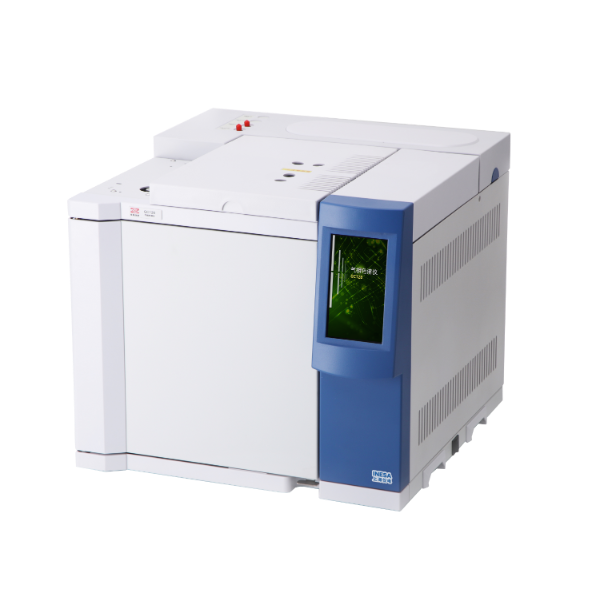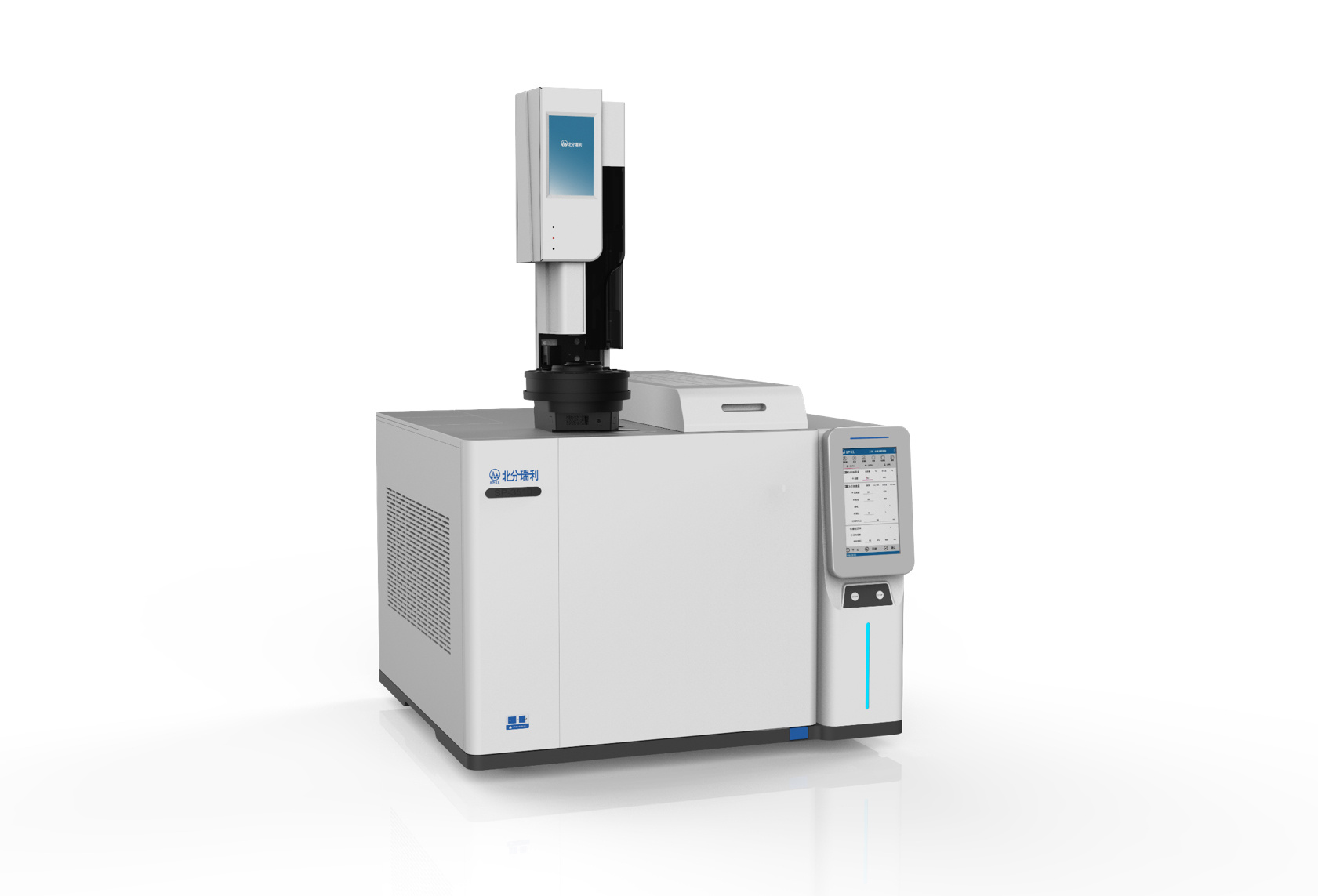氯硅烷单体的毛细管气相色谱柱分离分析
采用BN - 200ms 毛细管色谱柱实现了甲基三氯硅烷和二甲基二氯硅烷、苯基三氯硅烷和甲基苯基二氯硅烷等氯硅烷单体混合物的完全分离, 并得到气质联用分析的证实。
方案详情

有机硅材料,2007,21(1):41~43SIL ICONE MATERIAL分析测试 有 机 硅 材 料·42第21卷 氯硅烷单体的毛细管气相色谱柱分离分析* 蒋可志,倪 勇,蒋剑雄,邱化玉,邬继荣,来国桥** (杭州师范学院有机硅化学及材料技术教育部重点实验室,杭州310012) 摘要:采用BN-200ms毛细管色谱柱实现了基基三氯硅烷和二甲基二氯硅烷、苯基三氯硅烷和甲基苯基二氯硅烷等氯硅烷单体混合物的完全离,并得到汽质联用分析的证实。 关键词:苯基三氯娃:,甲基苯基二氯硅烷,甲基三氯硅烷,二甲基二氯硅烷,毛细管色谱柱,气相色谱,气质联用 中图分类号:TQ264.1*1 文献标识码:A 文章编号:1009-4369(2007) 01-0041-03 有机氯硅烷R,SiCl4-n(式中,R为Me、Et、Vi、Pr、Ph等)是制备有机硅聚合物(硅油、硅橡胶及硅树脂)以及其它官能基硅烷最重要的原料,是有机硅工业的基础。有机氯硅烷的化学性质极其活泼、沸点非常接近,各单体之间的色谱分离具有相当的难度,一直是有机氯硅烷工业的难点和技术关键。使用色谱技术分析氯硅烷单体已有较长的历史,特别在前苏联,采用填充柱色谱技术实现了氯硅烷单体的分离,由于当时制备色谱柱都采用涂渍法,色谱柱固定相的品种众多;因此,已有多篇使用填充柱色谱成功实现甲基苯基二氯硅烷和苯基三氯硅烷分离的报道[2-51。但填充柱色谱由于柱流量大、柱流失严重,难以与质谱仪联用 (商品化的气质联用仪没有使用填充柱色谱的))对复杂样品的各组分进行有效的分离分析。 目前通用型的毛细管色谱柱品种相对比较单一,无法实现甲基三氯硅烷和二甲基二氯硅烷、苯基三氯硅烷和甲基苯基二氯硅烷的有效色谱分离。尽管有文献报道使用DB-1毛细管色谱柱对甲基苯基二氯硅烷和苯基三氯硅烷进行气相色谱分析16],但结果没有得到气质联用的证实。笔者采用相同的色谱条件无法实现二者的有效分离。笔者还采用甲醇对甲基苯基二氯硅烷和苯基三氯硅烷进行甲氧基化,生成相应的甲氧基化产物,在色谱柱上实现有效的分离71;:但该实验对试剂要求相当苛刻,容易发生副反应,使定量的准确性受到影响。 本实验使用特殊涂层的毛细管色谱柱分别对含有甲基三氯硅烷和二甲基二氯硅烷的混合物体系及苯基三氯硅烷和甲基苯基二氯硅烷的混合物体系进行分离;并将毛细管气相色谱和质谱仪联用,对各组分进行定性定量分析。 1 实验 1.1 主要试剂及仪器 四氯化硅 ( SiCl4)、甲基三氯硅烷(MeSiCl3)、二甲基二氯硅烷(Mez SiCl2)、三甲基氯硅烷(Me3SiCl)、苯基三氯硅烷(PhSiCl3)、甲基苯基二氯硅烷(MePhSiCl2):自制,经气质联用仪验证;MePhSiCl单单体:经分馏提纯,华成有机硅材料有限公司。 气相色谱仪:FOCUS GC(配有FID检测器和Chrom- card 操作软件),装有BN-200ms毛细管柱:((30 m X0.25 mm X0.25 um)和 HP-5毛细管柱(30m×0.32 mm ×0.25 um),美国Thermo公司:;气质联用仪:Trace 2000 GC /DSQ MS (配有 Xcalibur 软件和 NIST V2.0谱库),装有BN-200ms毛细管柱(30m×0.25 mm X0.25 pm), 美国 Thermo 公司。 ( 收稿日期:2006-10-16。 ) ( 作者简介:蒋可志(1980→,男,助理研究员,主要从事 色谱、质谱研究。 ) ( 基金项目:浙江省高校青年教师资助计划项目(2005年)和浙江省教育厅资助科研项目(20051896)。 ) ( **联系人, E- m a il : gql a i @hztc.edu.cn。 ) 1.2 气质联用(GC-MS):分析条件 由于氯硅烷单体活泼,其GC-MS分析采用直接空针进样。甲基氯硅烷的沸点远低于苯基氯硅烷,所以分析条件不同。 甲基氯硅烷分析条件:气气室温度2000℃色谱柱内载气恒流流速((He)0)0.8 mL/min,柱温升温程序355℃℃X3 min -15 ℃/min -250℃×5 min,接口温度200℃, EI(+)源2000℃.电子轰击能量70eV,检测器电压1036V,扫描频率2次/s,质量范围35~450 amu。 苯基氯硅烷分析条件:气化室温度2400℃分流比为200:1;色谱柱内载气恒流流速(He):1.0mL/min,柱温升温程序50℃×1 min →15℃/min →240℃×10 min,接口温度250℃,EI(+)源200℃,电子轰击能量70 eV,检测器电压1036V,扫描频率2次/s,质量范围35~450 amu。 1.3 气相色谱(GC)分析条件 气化室温度240)℃,色谱柱内载气恒流流速(N2)1.5 mL/min,柱温升温程序50℃×1 min→15℃/ min →2500℃×5 min,检测器(FID)温度2700℃. 2 结果与讨论 2.1 甲基氯硅烷的 GC-MS分析 四氯化硅、甲基三氯硅烷、二甲基二氯硅烷和三甲基氯硅烷的沸点十分接近,分别为57.6℃、57.77 ℃、70.5℃和66.4 ℃81;因此,在通用型毛细管色谱柱上四氯化硅和甲基三氯硅烷、二甲基二氯硅烷和三甲基氯硅烷难以得到有效分离。图1为这四种标准化合物的混合物(量之比为1:1:1:1)采用装有BN-200ms毛细管柱的 GC-MS仪分析得到的总离子流图。通过NIST谱库搜确确认,图1中保留时间为1.94 min、2.11 min、2.33 min和2.50 min处的峰分别属于四氯化硅、三甲基氯硅烷、甲基三氯硅烷和二甲基二氯硅烷。 由图1可见,沸点仅差0.11℃的四氯化硅和甲基三氯硅烷能够像其它氯硅烷单体那样得到完全分离;而且在总离子流图中,沸点较高的三甲基氯硅烷却比沸点较低甲基三氯硅烷先出峰。这说明BN- 200ms毛细管柱的固定相除与氯硅烷单体存在范德华力弱作用之外,还与含有孤对电 子的分子或富电子分子产生配位、氢键等较为强烈的分子间作用。 图1 SiCl4、MeSiCl3、Mez SiCl2和Me SiCl的总离子流图 2.2 MePhSiCl2 和 PhSiCl3 的 GC-MS分析 图2为MePhSiCl2 和 PhSiCl3混合标样(其量之比为1.06:1.00)采用装有BN- 200ms 毛细管柱的 GC-MS仪分析得到的总离子流图。经NIST 谱库搜确确认,图2中保留时间为9.14 min处的峰属于苯基三氯硅烷,而保留时间为9.40 min处的峰属于甲基苯基二氯硅烷,二者已达到分离。 图2 MePhSiCl2和 PhSiCls 的总离子流图 图3 图2中保留时间为9.29 min (上图)和9.72 min (下图)的谱峰的质谱图 此外,图2中还出现保留时间为9.29 min和9.72 min 的两个在NIST谱库中检索不到的谱峰,其质谱见图3。根据其相对分子质量和同位素峰模式可以推断,保留时间为9.29 min 的谱峰属于甲基苯基甲氧基氯硅烷,保留时间为9.72 min的谱峰属于苯基甲氧基二氯硅烷。即甲基苯基二氯硅烷和苯基三氯硅烷上各有一个氯被甲氧基化了。这两个杂质峰是由于使用甲醇溶剂清洗进样针后残留的微量甲醇与氯硅烷反应产生的。令人意外的是图2中保留时间为9.29min的谱峰,处在苯基三氯硅烷和甲基苯基二氯硅烷的谱峰之间,且分别与这两个谱峰全达到基线分离;说明采用BN- 200ms毛细管色谱柱分离时,在甲基苯基二氯硅烷和苯基三氯硅烷的谱峰之间至少还可以有一个峰的容量,这更加证实BN-200ms毛细管色谱柱分离甲基苯基二氯硅烷和苯基三氯硅烷的有效性。 2.3甲基苯基二氯硅烷粗单体的 GC 分析 在使用氮气作为载气的气相色谱仪上,甲基苯基二氯硅烷和苯基三氯硅烷也能得到完全分离。图4a为甲基苯基二氯硅烷粗产品在BN-200ms毛细管柱上的气相色谱图。图4a中保留时间为6.47 min 和6.83 min 处的峰分别属于苯基三氯硅烷和甲基苯基二氯硅烷,由面积归一化法测得其含量分别为2.9%和96.1%。 换用HP-5毛细管柱后,在其它条件不变的条件下,苯基三氯硅烷和甲基苯基二氯硅烷在色谱图上根本没有得到分离的迹象(见图4b),其主峰的面积百分含量为99.1%,几乎与BN-200ms毛细管柱上苯基三氯硅烷和甲基苯基二氯硅烷这两个峰的百分含量之和相同。通过比较图4a和图4b进一步确认,BN- 200ms毛细管色谱柱对氯硅烷单体分离的有效性。 图4 甲基苯基二氯硅烷粗单体的GC 谱图 a-BN-200ms毛细管柱;b-HP-5毛细管柱 3 结论 采用特殊涂层的BN- 200ms毛细管色谱柱实现了四氯化硅、甲基三氯硅烷、二甲基二氯硅烷和三甲基氯硅烷以及甲基苯基二氯硅烷和苯基三氯硅烷的完全分离,并得到气质联用分析的验证。该方法实用方便,可用于缩合法生产的苯基氯硅烷单体的生产分析,并为氯硅烷单体的质量控制提供了参考。 ( 参考文献 ) ( [1] 幸松民,王一璐.有机硅合成工艺及产品应用 [M] . 北京:化学工业出版社,1999:25-127. ) ( [21 SHVETSOVA ZA, KHOZHAINOVA Z I. Gaschromatographic analysis of the reaction mixture and condensate f rom m e thylphenyldichlorosilane p r oduc- tion [J].] Metody Analiza i K ontrolya KachestvaProduktsi i v Khimicheskoi Promyshlennosti, 1978(6): 1 0-12. ) ( [3] WURST M,VYCHODOCESKE C, ZAVODY C.Analysis of organosilicon compounds.V. D etermi- nation of a mixture of phenylchlorosilanes and chlorinated p henylchlorosilanes by g as chromatography by using the gas d ensity b alance [ J]. Collect C z ech Chem Commun, 1969,34(11):3297-3308. ) ( [4] YUDINA, I P, KHOKHLOVA L A,SIDOROVA L P, et al. ( Chromatograp hic d etermination of phenyltrichlorosilane impurity in methylphenyldichlorosilane [J ] . Gazovayai a Khro- matografiya,196 6 (4): 1 34-135. ) ( [5] AINSHTEIN A A, SHUL YATEVA TI, DAROVSKIKHO P. Analysis of methylphenyldichlorosilane condensate by g as c hro- matography [J]. Deposite d Doc.198 1 ,(SPSTL255Khp-D81): 7 . ) ( [6] 来国桥,傅水玉.毛细管气相色谱法测定苯基氯 硅烷. 有机硅材料,2002,16(6):18-21. ) ( [7] 蒋可志,蒋剑雄,来国桥,等.甲基苯基氯硅烷和苯基三氯硅烷混合物的GC-MS分析.分析测 试学报,2006,25(3):106-108. ) ( [8] 徐蔓,夏叶清.中国化工产品大全:上册[M1第3版.北京:化学工业出版社,2000:296. ) monomers began at 250 ℃. the electrical resistivity of theresin film, which fully cured and aged at 200℃ for 30min ,could reach 1000MQ. 'The non toxic film also showed goodadhesion and hardness. Keywords: silicone resin, siloxane oligomerization, electricalresistivity, thermal stability, storage time Synthesis of amino silicone fluid with high viscosity. SU Yurguang (Quzhou Chemical Group, Quzhou 324004, Zhe-jiang). Youjigui Cailiao, 2007,21(1): 33-35. Abstract: A new synthesis method of low molecular weighta, w dihydroxy polydimethyl siloxane and N-B- aminoethyl-Y-diethylaminopropylmethyldimethoxy silane and method ofviscosity control were introduced. The results indicated thatthe viscosity of the amino silicone fluid prepared by thismethod was higher than traditional method, and the reactiontemperature was lower than traditional method.l.The fabrictreated with silicone micro emulsion had excellent hand feeland smoothness. Keywords: amino silicone fluid, a,,(w dihydroxy poly-dimethyl siloxane. N-B-aminoethyl-y-diethylamino-propylmethyldimethoxy silane Preparation and application of amino and dodecyl co modified polysiloxanes.HUANG Liang xian, AN Qiurfeng, LIMing tao, YANG Gang, WANG Qiarrjin, FU Yong-shan(College of Chemistry and Chemical Engineering, Shanxi U-niversity of Science& Technology, Xianyang712081.Shanxi). Youjigui Cailiao, 2007,21(1):36-40. Abstract: In the presence of tetramethylammonium hydroxide(TMAH) as catalyst, a new softener amino and dodecyl co-modified polysiloxanes (ADMPS)was synthesized by bulkpolymerization of octamethylcyclotetrasiloxane (D4), N-Baminoethyry-aminoproylmethyldimethoxysilane (YDH602),dodecylmethyldimethoxysilane (HD-109) and hexamethyldis-iloxane (MM). The chemical structure of ADMPS was characterized by IR and 'H NMR. It was applied for the condi-tioning of 100 % white cotton. The results showed that whenthe amino value of ADMPS was increased, the bending rigidi-ty of the treated cotton decreased and its wrinkle recovery an-gle increased, which enhanced soft hand feel , the elasticityand the anticrease performance of the treated cotton. As thealkyl value of ADMPS was increased, the softeness, elasticityand the anticrease performance of the treated cotton declined alittle, and the whiteness and wettability unchanged.The re-sults showed that at similar amino content, the wettabilityand smoothness of cotton treated with ADMPS (alkane value0.3mmol/g) was better than that with N-B-aminoethyly-aminopropylpolydimethylsiloxanes (ASO-1), the whiteness oftreated cotton fabric was as the same as that treated by ASO-1, whereas the softness and wrinkle recovery angle of the cot-ton treated with ASO1 was better than that treated withADMPS. Keywords : N-B-qaery-diethylaminopropylmethyldimethoxysilane, polysiloxanes, amino silicone fluid, dodecyl polysilox-anes, textile, softening agent Analysis of methylchlorosilicanes & phenylchlorosilicanes by ( GC &GCMS withh microcolumn . JIANG Kezhi, NI Yong, JIANGJianxiong, QIU Hua yu, W U Ji rong, LAIGuo-qiao (Key L ab of Organosilicon Chemistry and M aterial Technology of Ministry of Education, Hangzhou T e achersCollege, Hangzhou 310012, Z h ejiang). . Youjigui Cailiao , 2007,21(1):41-43. ) Abstract: The complete separation of chlorsilane mixture ofphenyltrichlorosilane, dimethyldichlorosilane , methyl-trichlorosilane and methyl phenyldichlorosilicane were realizedwith BN-200ms micro-column, which was confirmed by GCMS. Key words :pphenyltrichlorosilane, dimethyldichlorosilane,methyltrichlorosilane, methyl phenyldichlorosilicane, microcolumn, GC-MS, GC The latest application development of polysiloxane modifiedpolyurethane.CHEN Xue-juan, ZHU Jie, HUANG Shrqiang (Faculty of Material Science and Engineering, HubeiUniversity,Wuhan 430062, Hubei). Youjigui Cailiao,2007,21(1):44-47. Abstract : The latest research and application development ofpolysiloxane modified polyurethane in the field of polymer di-electric, biomedicine and membranes materials etc were reviewed. Key words : polysiloxane, polyurethane Research progress in synthesis of 1,1,1,3,5,5,5-hep-tamethyltrisiloxane.e。WU Luyan, ZHAN Xiao-li, CHENFeng qiu (UNILAB Research Center of Chemical ReactionEngineering, Zhejiang University, Hangzhou 310027, Zhejiang)..Youjigui Cailiao , 2007,21(1):48-52. Abstract: The synthesis methods of 1,1,1,3,5,5,5-hep-tamethyltrisiloxane (MD"M) were reviewed. Then the reac-tion mechanism of hydrolysis and condensation polymerizationof methylchlorosilane was analyzed.In the end, future direction of preparation of MD"M in the future was pointed out. Key words : heptamethyltrisiloxane, methylchlorosilanes, hy-drolyzation, condensation The blending technology of mixed silicone Rubber (VII).HUANG Wenr run (Chenguang Research Institute of Chemistry Industry, China Bluestar , Chengdu 610041, Sichuan)Youjigui Cailiao, 2007,21(1):53-57. Abstract: The blending technology of four types of siliconerubber compound for automobile, i. e. axial seal and conrnecting shaft protective casing, gaskets for engine system andwaterproof connector, were introduced Key words : silicone rubber, automobile, axial seal, gasket,oil resistivity, fatigue resistance, selflubricity ◎China Academic Journal Electronic Publishing House. All rights reserved. http://www.cnki.net
确定

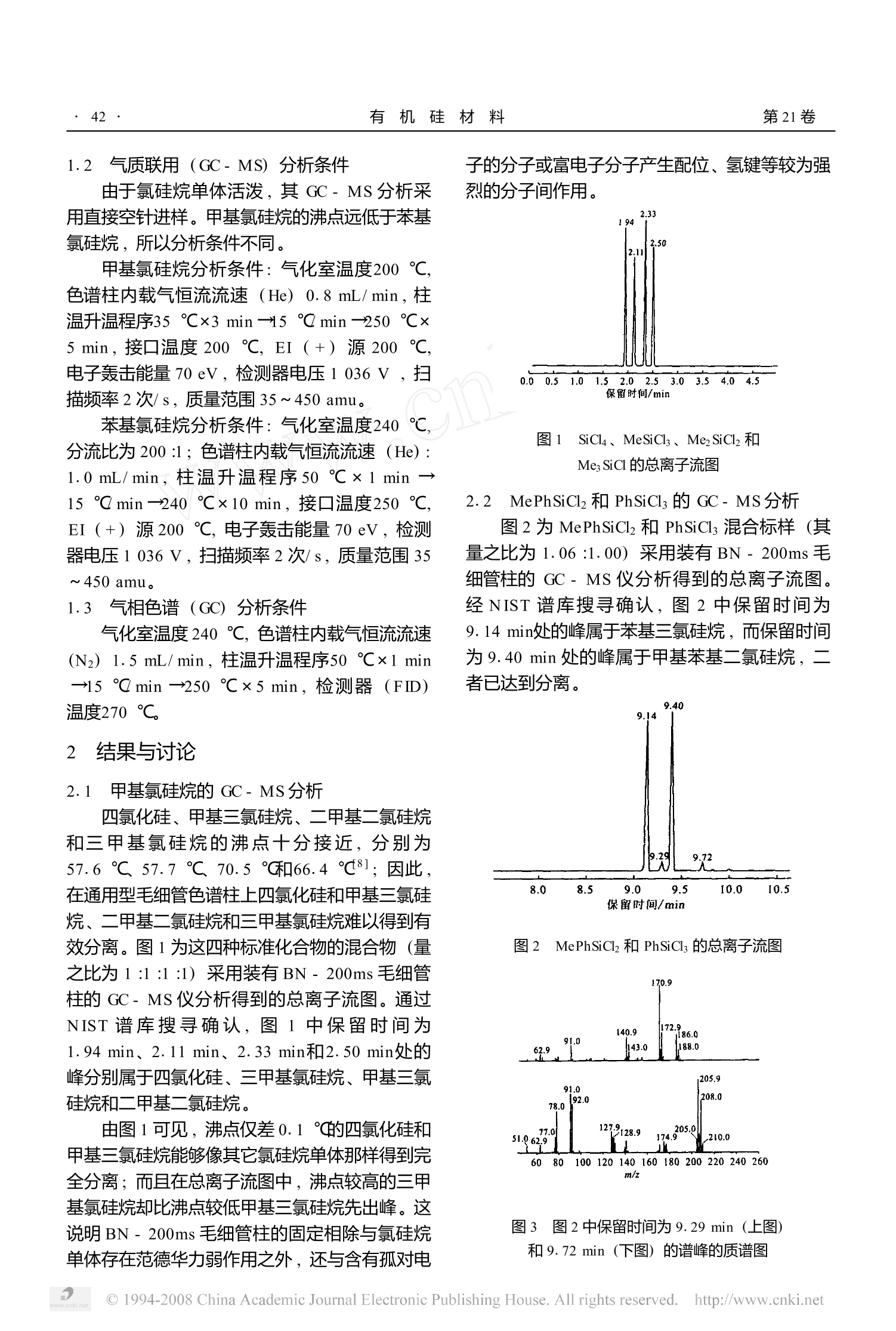
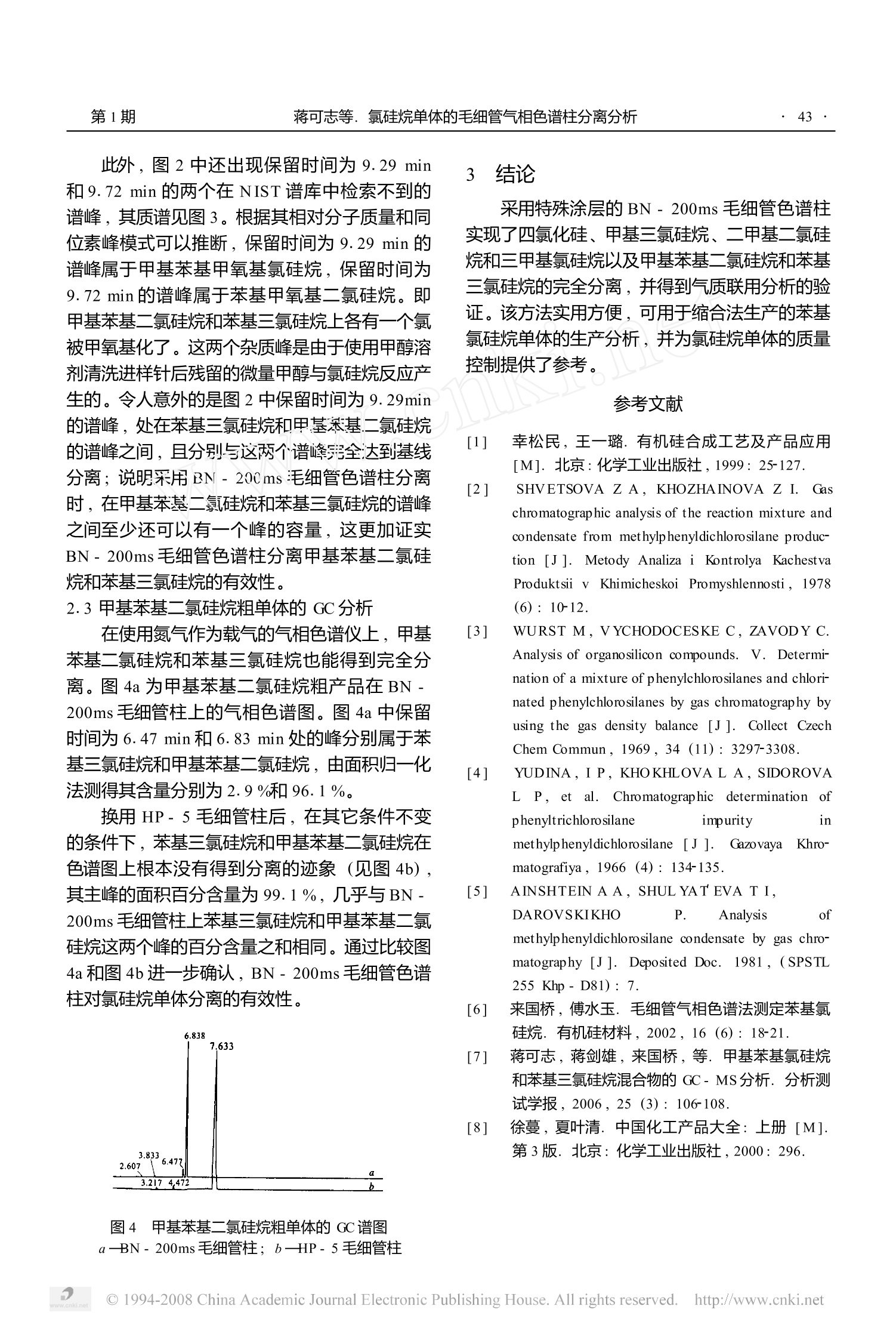
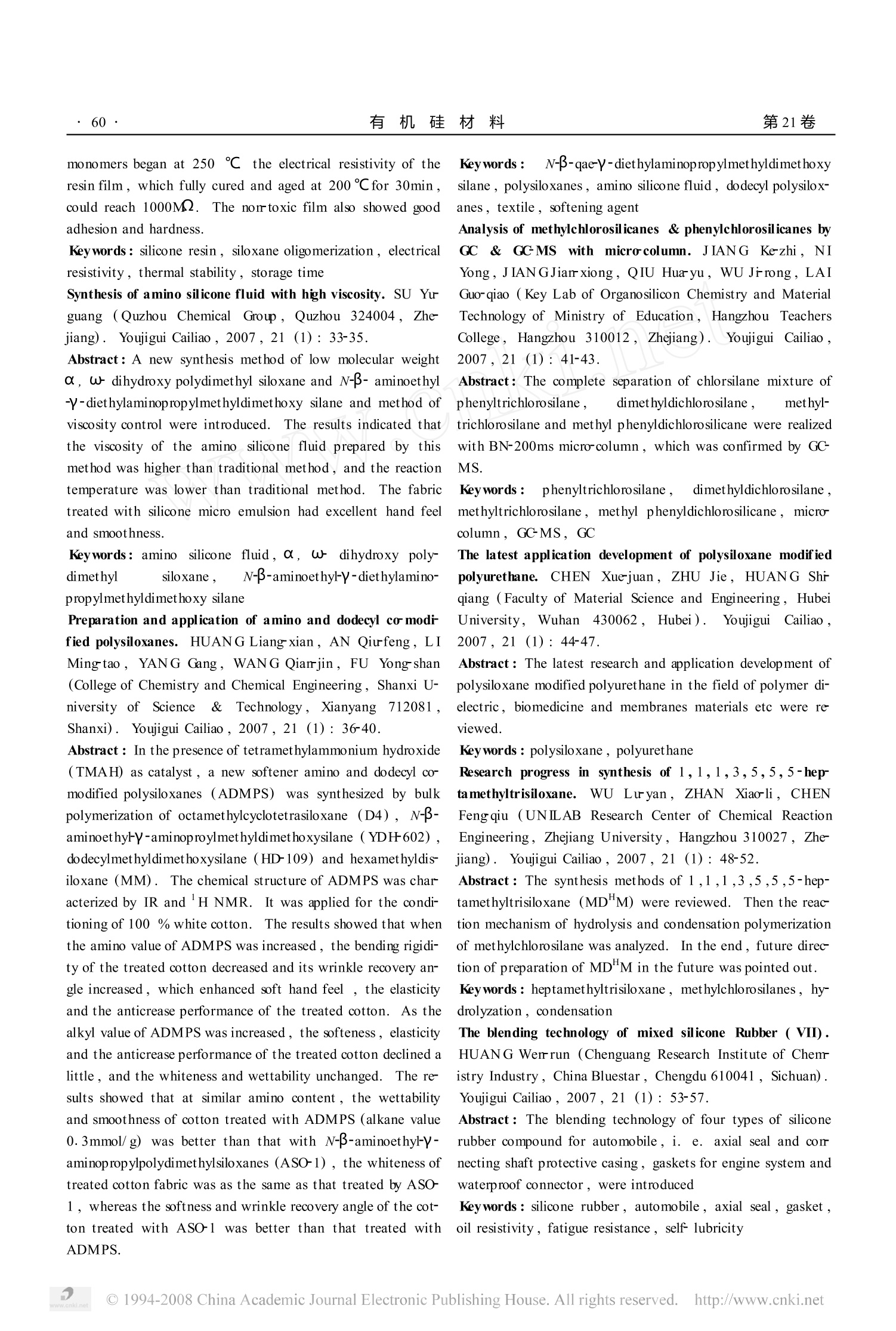
还剩2页未读,是否继续阅读?
苏州市莱顿科学仪器有限公司为您提供《有机氯硅烷中分离分析检测方案(气相色谱仪)》,该方案主要用于化工原料中分离分析检测,参考标准--,《有机氯硅烷中分离分析检测方案(气相色谱仪)》用到的仪器有安捷伦7890B气相色谱仪/FID+自动进样器/现货
推荐专场
相关方案
更多

